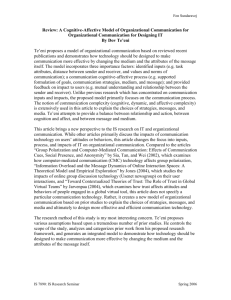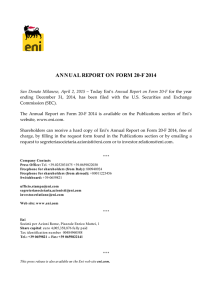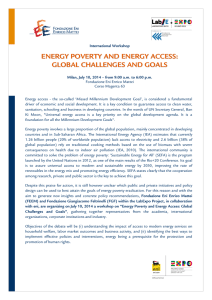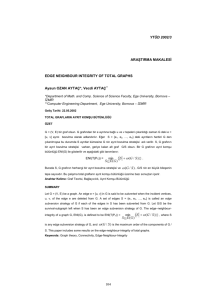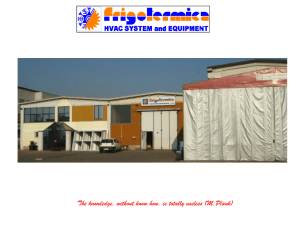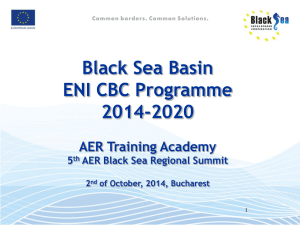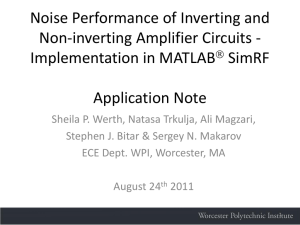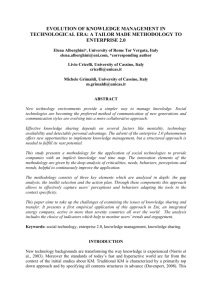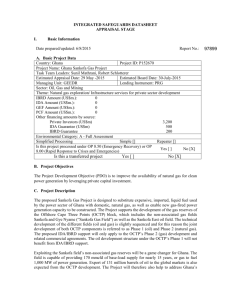exploration & production
advertisement
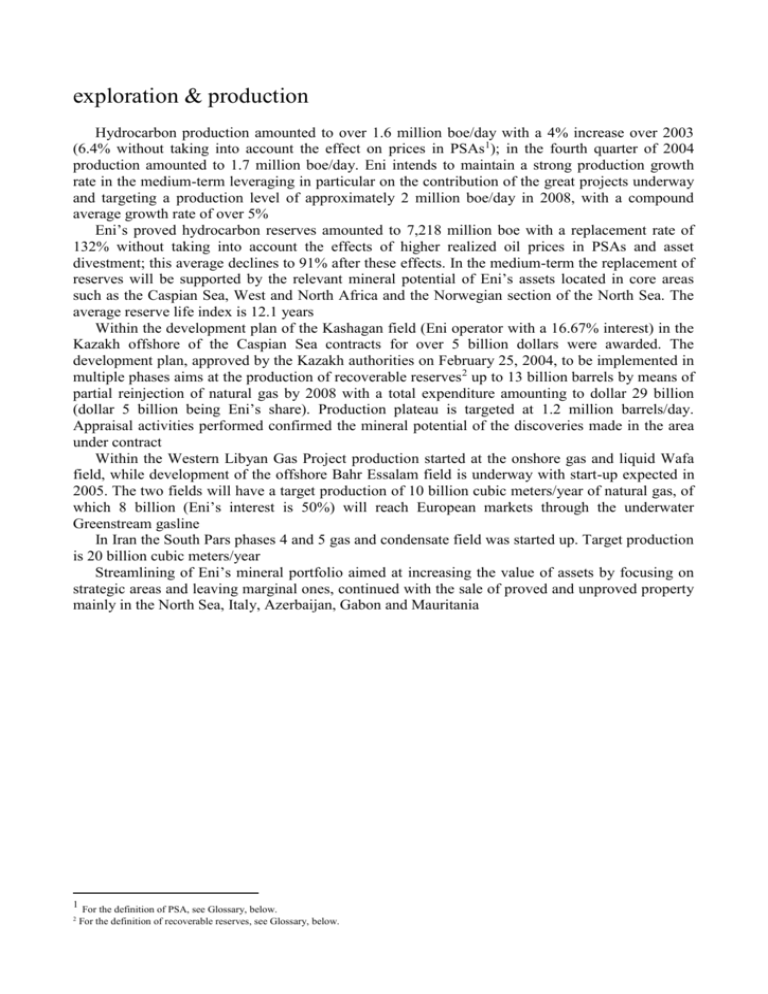
exploration & production Hydrocarbon production amounted to over 1.6 million boe/day with a 4% increase over 2003 (6.4% without taking into account the effect on prices in PSAs1); in the fourth quarter of 2004 production amounted to 1.7 million boe/day. Eni intends to maintain a strong production growth rate in the medium-term leveraging in particular on the contribution of the great projects underway and targeting a production level of approximately 2 million boe/day in 2008, with a compound average growth rate of over 5% Eni’s proved hydrocarbon reserves amounted to 7,218 million boe with a replacement rate of 132% without taking into account the effects of higher realized oil prices in PSAs and asset divestment; this average declines to 91% after these effects. In the medium-term the replacement of reserves will be supported by the relevant mineral potential of Eni’s assets located in core areas such as the Caspian Sea, West and North Africa and the Norwegian section of the North Sea. The average reserve life index is 12.1 years Within the development plan of the Kashagan field (Eni operator with a 16.67% interest) in the Kazakh offshore of the Caspian Sea contracts for over 5 billion dollars were awarded. The development plan, approved by the Kazakh authorities on February 25, 2004, to be implemented in multiple phases aims at the production of recoverable reserves 2 up to 13 billion barrels by means of partial reinjection of natural gas by 2008 with a total expenditure amounting to dollar 29 billion (dollar 5 billion being Eni’s share). Production plateau is targeted at 1.2 million barrels/day. Appraisal activities performed confirmed the mineral potential of the discoveries made in the area under contract Within the Western Libyan Gas Project production started at the onshore gas and liquid Wafa field, while development of the offshore Bahr Essalam field is underway with start-up expected in 2005. The two fields will have a target production of 10 billion cubic meters/year of natural gas, of which 8 billion (Eni’s interest is 50%) will reach European markets through the underwater Greenstream gasline In Iran the South Pars phases 4 and 5 gas and condensate field was started up. Target production is 20 billion cubic meters/year Streamlining of Eni’s mineral portfolio aimed at increasing the value of assets by focusing on strategic areas and leaving marginal ones, continued with the sale of proved and unproved property mainly in the North Sea, Italy, Azerbaijan, Gabon and Mauritania 1 2 For the definition of PSA, see Glossary, below. For the definition of recoverable reserves, see Glossary, below. Proved oil and natural gas reserves Proved oil and gas reserves are the estimated quantities of crude oil (including condensates and natural gas liquids) and natural gas which geological and engineering data demonstrate with reasonable certainty to be recoverable in future years from known reservoirs under existing technical, contractual, economic and operating conditions as of the date the estimate is made. Prices include consideration of changes in existing prices provided only by contractual arrangements, but not on escalations based upon future conditions. Eni has always held direct control over the booking of proved reserves. The Reserve Department of the Exploration & Production Division, reporting directly to the General Manager, is entrusted with the task of keeping reserve classification criteria (“criteria”) constantly updated and of monitoring their periodic process of estimate. The criteria follow the United States rules issued through the Financial Accounting Standard Board and the Security and Exchange Commission as well as, on specific issues non regulated by rules, the consolidated practice recognized by qualified reference institutions. The current criteria applied by Eni have been examined by DeGolyer and MacNaughton (D&M) an independent oil engineers company, which confirmed that they are compliant with the SEC rules. D&M also stated that the criteria regulate situations for which the SEC rules are less precise, providing a reasonable interpretation in line with the generally accepted practices in international markets. Eni estimates its proved reserves on the basis of the mentioned criteria also when it participates to exploration and production activities operated by other entities. From 1991 Eni has requested qualified independent oil engineers companies to carry out an independent evaluation3 of its proved reserves on a rotative basis. In particular in 2004 a total of 2.2 billion boe of proved reserves, or about 30% of Eni’s total proved reserves at December 31, 2004, have been evaluated. The results of this independent evaluation confirmed Eni’s evaluations, as they did in past years. In the 2003-2004 two-year period independent evaluations concerned 63% of Eni’s total proved reserves; in particular evaluations concerned all the new development projects, including Kashagan, and most large-sized mature fields. Further information on reserves are provided in Note 27 to Eni’s consolidated financial statements “Supplemental oil and gas information for the exploration and production activities - Oil and natural gas reserves”. Eni’s proved reserves of hydrocarbons at December 31, 2004 totaled 7,218 million boe (oil and condensates 4,008 million barrels; natural gas 3,210 million boe) slightly decreasing (down 0.7%) over December 31, 2003. The reserve replacement ratio was 132% without taking into account the effects of higher realized oil prices in PSAs4 (161 million boe) and asset divestment (81 million boe); this average declines to 91% after these effects. Before the effect of prices in PSAs proved reserves booked in the year were 782 million boe. The average reserve life index is 12.1 years (12.7 at December 31, 2003). The following table describes the evolution of proved reserves in 2004. After the PSAs’ price effect, proved reserves booked in 2004 (621 million boe) derived from: (i) extensions and discoveries (329 million boe) in particular in Kazakhstan, Egypt, Libya, Australia, Angola and the United Kingdom; (ii) revisions of previous estimates (227 million boe) in particular in Egypt, Libya, Iran, Congo, Pakistan, Angola and Norway, offset in part by decreasing revisions in Kazakhstan and Algeria related to the PSAs’ price effect, and the United States; (iii) improved recovery (65 million boe) in particular in Angola and Algeria. These increases offset in part the decline related to production for the year (594 million boe) and sales of minerals in place in the 3 From 1991 to 2002 to DeGolyer and MacNaughton, from 2003 also to Ryder Scott. In PSAs the national oil company awards the execution of exploration and production activities to the international oil company (contractor). The contractor bears the mineral and financial risk of the initiative and, when successful, recovers capital expenditure and costs incurred in the year (cost oil) by means of a share of production. This production share varies along with international oil prices. In certain PSAs changes in international oil prices affect also the share of production to which the contractor is entitled in order to remunerate its expenditure (profit oil). 4 British section of the North Sea, Italy, Gabon, Azerbaijan, the Netherlands and Egypt (81 million boe). Estimated proved developed reserves at December 31, 2004, amounted to 4,300 million boe (2,471 million barrels of oil and condensates and 1,829 million boe of natural gas), representing 60% of total estimated proved reserves (58% at December 31, 2003). Proved reserves of hydrocarbons applicable to long-term supply agreements with foreign governments in mineral assets where Eni is operator represented approximately 10% of all proved reserves at December 31, 2004 (8% at December 31, 2003). Mineral right portfolio and exploration activities As of December 31, 2004, Eni’s portfolio of mineral rights consisted of 9195 exclusive or shared rights for exploration and development in 34 countries on five continents, for a total net acreage of 234,1806 square kilometers (242,635 at December 31, 2003). Of these, 41,997 square kilometers concerned production and development (43,879 at December 31, 2003). Outside Italy net acreage decreased by 1,881 square kilometers due to the divestment of assets in Gabon, Mauritania, Senegal, the British section of the North Sea, the Netherlands and Egypt, and releases, in particular in Australia and Congo. Increases were registered in Saudi Arabia, Indonesia, Norway and Russia. In Italy net acreage declined by 6,575 square kilometers due to the divestment of assets, whose effects were offset in part by the awarding of 7 new concessions. A total of 66 new exploratory wells were drilled (29.5 of which represented Eni’s share), as compared to 105 exploratory wells completed in 2003 (43 of which represented Eni’s share). Overall success rate was 52.1% as compared to 46.7% in 2003; the success rate of Eni’s share of exploratory wells was 57.3% as compared 45.7% in 2003. Mineral portfolio rationalization Within the rationalization strategy of its asset portfolio, aimed at increasing its value by focusing on strategic areas with good growth potential and leaving marginal areas, Eni defined the following agreements: - the sale of Eni’s interests in Blocks T (Eni operator with an 88.74% interest) and B (Eni operator with an average 70.2% interest) located in the British section of the North Sea off the Scottish coast to Canadian Natural Resources Ltd for euro 158 million. The T Block includes the Tiffany, Tony and Thelma producing fields, while the B Block includes the Balmoral, Stirling and Glamis fields; - the sale of the entire share capital of Stargas SpA to Gas Plus for euro 139 million. Stargas (Eni’s interest 100%) is a newly-established company, to which the Società Petrolifera Italiana (Eni’s interest 99.96%) business was transferred that included: (i) 42 natural gas and condensate production concessions and 3 exploration permits, located mainly in the production areas of Fornovo Taro, Montecorsaro, Lucera and Policoro in central-southern Italy; (ii) gas transmission and treatment infrastructure; (iii) real estate; (iv) Eni’s 81.63% interest in Reggente; - the sale to the Russian company Lukoil for euro 114 million of Eni’s entire stake (50%) in LukAgip, the remaining 50% owned by Lukoil itself, holder of a 10% interest in the Shakh Deniz field under development in the Azeri Caspian Sea and some minority stakes in companies operating in the transport and sale of gas in Azerbaijan, as well as a 24% interest in the onshore Meleiha field, in Egypt, operated by Eni; - the sale of Eni’s interest in the Markham and JC3 gas fields located in the southern section of the North Sea to CH4 Energy Ltd for euro 39 million; - the sale of Eni’s proved and unproved property in Gabon consisting of its interests in the offshore Limande oil field (Eni operator with an 80% interest) and in three offshore exploration 5 6 Of these, 5 are owned through affiliates for initiatives in Saudi Arabia, Russia and Spain. Of these 27,421 square kilometers are owned through affiliates for initiatives in Saudi Arabia, Russia and Spain. permits M’Polo, Chaillu and Meboun (Eni operator with a 50% interest) to the independent oil company Perenco for euro 23 million; - the sale of exploration permits in Mauritania and marginal interests located offshore in the Gulf of Mexico. The transactions described above entailed proceeds of euro 548 million. Production In 2004 daily hydrocarbon production amounted to 1,624,000 boe increasing by 62,000 boe over 2003, up 4%, due to: (i) production increases registered mainly in Nigeria, Angola, Kazakhstan, Pakistan, Libya and Egypt; (ii) the start-up of fields in Angola, Australia, Algeria and Libya. These increases were partly offset by: (i) declines in mature fields mainly in Italy and the United Kingdom; (ii) lower production entitlements (38,000 boe) in PSAs related to higher international oil prices; (iii) the effect of the divestment of assets (13,000 boe). The share of production outside Italy was 83.3% (80.8% in 2003). Daily production of oil and condensates (1,034,000 barrels) increased by 53,000 barrels over 2003, up 5.4%, due to increases registered in: (i) Nigeria, due to the start-up of the Okpoho field (Eni’s interest 100%) and the reaching of full production of the Abo (Eni operator with a 50.19% interest) and the Nase-EA (Eni’s interest 12.86%) fields; (ii) Angola, due to the reaching of full production at the Xicomba field and the start-up of the fields of the Kizomba A area in Block 15 (Eni’s interest 20%); (iii) Kazakhstan, in the Karachaganak field (Eni co-operator with a 32.5% interest) due to the beginning of exports from the Novorossiysk terminal on the Russian coast of the Black Sea; (iv) Venezuela, due to the fact that in early 2003 production had been interrupted during a general strike; (v) Australia, due to the reaching of full production at the Woollybutt field (Eni operator with a 65% interest) and the start-up of the Bayu Undan field (Eni’s interest 12.04%); (vi) Libya, due to the start-up of the Wafa (Eni’s interest 50%) and Elephant fields (Eni’s interest 33.33%); (vii) Algeria, due to the start-up of the Rod and satellite fields (Eni operator with a 63.96% interest). These increases were partly offset by declines of mature fields in particular in the United Kingdom and by the effect of the divestment of assets. In Italy the production decline of mature fields (in particular Villafortuna/Trecate, Ragusa and Aquila) was offset in part by higher production in Val d’Agri notwithstanding the standstills related to the connection of the fourth treatment train of the oil center. Daily production of natural gas (590,000 boe) increased by 9,000 boe over 2003, up 1.5%, due essentially to increases registered in: (i) Pakistan due to the reaching of full production at the Sawan (Eni’s interest 23.68%) and Bhit (Eni operator with a 40% interest) fields; (ii) Egypt for the increase in local demand; (iii) Libya, due to the start-up of the Wafa field (Eni’s interest 50%); (iv) Kazakhstan, Norway (reaching of full production of the Mikkel field, Eni’s interest 14.9%) and Nigeria. These increases were offset in part by declines of mature fields in particular in Italy and the United Kingdom and the effects of divestments. Hydrocarbon production sold amounted to 576.5 million boe. The 18.1 million boe difference over production was due essentially to own consumption of natural gas (13.9 million boe) and lower withdrawals as compared to allotted shares (over/underlifting7) outside Italy for 4 million boe. About 70% of oil and condensate production sold (374.3 million barrels) was destined to Eni’s Refining & Marketing segment (70% in 2003). About 40% of natural gas production sold (32.9 billion cubic meters) was destined to Eni’s Gas & Power segment (43% in 2003). Main exploration and development projects North Africa 7 Agreements between partners regulate the right to withdraw proportional production volumes in the period. Higher or lower production volumes withdrawn as compared to entitlements determine a temporary over or underlifting. Algeria in Block P 404 area B (Eni’s interest 25%) in the Berkine North East area, near the Ourhoud field, the BKNE-B-2 appraisal well confirmed the presence of hydrocarbons at a depth of about 3,000 meters. In October 2004 production of the ROD and satellites oilfields (Eni’s interest 63.96%) in early production in the Bir Rebaa oil center started with a flow of 8,000 barrels/day. These fields are located in Blocks 401a/402a and 403a/403d. In December 2004 the treatment plant started operations with a capacity of 80,000 barrels/day and production net to Eni is expected to reach a 28,000 barrels/day peak in 2005. In December 2004 the REC field located near the Bir Rebaa oil center started production at an initial level of over 2,000 barrels/day net to Eni. Egypt Hydrocarbons were discovered in the following concessions: (i) Sinai 12 leases (Eni’s interest 50%) located offshore in the Gulf of Suez, where the BMW-1 exploration well found four oil mineralized levels and was linked to existing production facilities; (ii) Ras el Barr (Eni’s interest 25%) located offshore in the Nile Delta, where the Taurt-1 and Taurt-2 exploration wells found gas mineralized levels; (iii) Ashrafi (Eni’s interest 50%) located in the Gulf of Suez where the Ashrafi H 1X Dir and Ashrafi J-1X Dir showed oil mineralized levels. The first well was linked to existing production facilities. In the Port Fouad concession (Eni’s interest 50%) two gas discoveries were made with the Anshuga 1 and Gambari 1 wells. Development activities are ongoing in the natural gas fields located in the following concessions in the Nile Delta offshore: (i) North Port Said (Eni’s interest 50%) where the Nouras A and Nouras B fields started production. Construction work continued at the Barboni development platform and for the extension of the El Gamil terminal. In 2004 daily production of gas increased from 7 to 9.9 million cubic meters/day net to Eni; (ii) Baltim (Eni’s interest 25%) where work continued for the installation of the Baltim North platform and relevant onshore facilities at Abu Madi, whose completion is expected by the end of 2005 in order to meet the contract production level of 6 million cubic meters per day (1.8 million net to Eni); (iii) El Temsah (Eni operator with a 25% interest) where the project includes four steps. Production is expected to start in the first quarter of 2005 from the recently installed Temsah 4 platform (step 2) which will allow to offset the production decline related to an accident occurred in August to the Temsah NW platform. Peak production at 5.2 million cubic meters/day is expected in 2008. Libya In January 2004, early production started at the Elephant oil field (Eni’s interest 33.33%) in the NC-174 permit, about 860 kilometers south of Tripoli. Activities underway include: (i) drilling and workover of the 51 development wells envisaged by the project; (ii) construction of a new 725kilometer long pipeline connecting the field with the Mellitah terminal. The first and second treatment trains started operating in April and August respectively with a 100,000 barrels/day capacity each. Peak production is expected in 2007 with 27,000 barrels/day net to Eni. Within the Western Libyan Gas project, in July production of oil and in August of gas and condensates started at the Wafa onshore field in permit NC-169A. By year-end production reached 45,000 boe/day net to Eni. Development is underway of the Bahr Essalam field located in the NC41 permit in the Mediterranean offshore, where production is expected to start in mid-2005. Peak production from the two fields at 240,000 boe/day (124,000 boe/day net to Eni) is expected in 2006. Supply in Italy of natural gas through the underwater Greenstream gasline linking Mellitah to Sicily started on October 1 as planned. The gasline will allow the export of 8 billion cubic meters per year of natural gas to third parties in Italy (4 billion being Eni’s share - see, Gas & Power - Development projects). West Africa Angola The exploration license for Block 14 (Eni’s interest 20%) has been extended to March 1, 2007. In Block 14K/A-IMI (Eni’s interest 10%), deriving from the unitization of areas formerly belonging to Block 14 and to Block Haute Mer (Congo), the Lianzi 1 well yielded 12,000 barrels day of high quality oil in test production. In May 2004 the extension until December 31, 2030 of the exploration and production license for Block 0 - Cabinda (Eni’s interest 9.8%) was approved. In this area development of the oil and condensate North Sanha and Bomboco fields continued. The project provides for the drilling of 50 wells and the installation of an FPSO (Floating Production Storage Offloading) vessel for the export of LPG that is going to be the largest in the world for LPG. Gas cycling on North Sanha will reduce gas flaring by 50%. Production started in January 2005 and is expected to peak at 100,000 barrels/day (11,000 net to Eni) in 2007. The BBLT project is underway and provides for the development of the Benguela, Belize, Lobito and Tomboco oilfields at a depth between 300 and 500 meters in Block 14 (Eni’s interest 20%), the drilling of 50 wells and the installation of a Compliant Tower on which production facilities will be installed. Production is scheduled to start in 2006, reaching a peak of 214,000 barrels/day (34,000 net to Eni) in 2008. In August 2004 the Hungo and Chocalho oil fields started production within Phase A of the development project for the fields discovered in the area called Kizomba in Block 15 (Eni’s interest 20%) in the Angolan offshore at a water depth of about 1,500 meters. A total of 59 wells will be drilled and complemented by an underwater system connected to a Tension Leg Platform linked to an FPSO vessel, that is the largest in the world in its class with a treatment capacity of 250,000 barrels/day. Production is expected to peak at 43,000 barrels/day net to Eni by 2006. In this same area Phase B is underway under a scheme similar to that of Phase A, aimed at the development of the Kissanje and Dikanza fields. Production is expected to start in the fourth quarter of 2005 and to peak at 250,000 barrels/day (43,000 net to Eni) by 2007. In Block 15 in 2004 the Mondo project was approved within Phase C of the development of the Kizomba area. Congo In February 2004 an oil discovery was made in Mer Très Profonde Sud permit (Eni’s interest 30%) with the Pegase Nord Marine 1 exploration well which yielded 14,000 barrels/day in test production from four mineralized levels. Drilling was performed with the Saipem 10000 vessel and reached the final depth of 3,900 meters. In 2004 evaluation of the mineral potential of blocks operated by Eni continued. Nigeria Three discoveries were made in onshore production areas: (i) in the OML 63 permit (Eni operator with a 20% interest) with the Osiama Creek South 1 Dir and 2 Dir wells both containing oil; (ii) in the OML 74 permit (Eni’s interest 12.86%) with the JK G-1x well containing oil and gas. Development continued in the OML 60 and 61 permits (Eni operator with a 20% interest) intended to supply natural gas to the Bonny liquefaction plant (Eni’s interest 10.4%); when fully operational Eni’s gas supplies to the plant will amount to 24.1 million cubic meters/day. Engineering activities (FEED) concerning the construction of the second Brass LNG liquefaction plant (Eni’s interest 17%) were started. Eni will supply 24.1 million cubic meters/day for the first two trains. Construction continued of the Kwale-Okpai power station (IPP project - Eni operator with a 20% interest) which will be fired from the first quarter of 2005 with gas from the Kwale fields located in the OML 60 permit, that will supply 2 million cubic meters/day of gas when fully operational. The project is part of the Nigerian Government and Eni’s plan of zero gas flaring. Development of the Bonga oil field (Eni’s interest 12.5%) continued. The field is located in the offshore OML 118 permit at a water depth between 950 and 1,150 meters. Exploration, still underway, was successful with the Bonga West well that found various mineralized levels. Production is expected to start in late 2005, with a peak flow of 190,000 barrels/day (21,000 net to Eni) in 2007. In the offshore OML 119 permit (Eni operator of the service contract), in January 2004 the FPSO Mystras started operations. Drilling, connection and production start-up of the Okpoho platform were completed. Production from the Okono and Okpoho oil fields amounted to about 55,000 barrels/day (27,000 net to Eni). Eni also holds a 5% interest in the NASE, the largest oil joint venture in the country relating to 36 onshore blocks. The major development projects underway are Cawthorne Channel and Forcados/Yokri aiming at drilling infilling wells in producing fields and expanding existing production facilities. In March 2005 natural gas production started at Cawthorne Channel (3.8 million cubic meters/day), in October at Forcados/Yokri (2.3 million cubic meters/day) destined to the Bonny liquefaction plant. Oil production from the two fields is expected to peak at 90,000 barrels/day of oil (5,000 net to Eni) in 2006. North Sea Norway In June 2004 Eni was awarded four exploration licenses (PL324, PL329, PL325 and PL323) in the Norwegian Sea, the latter two as operator with a 40% interest. According to Eni these licenses have great mineral potential and represent a new strengthening opportunity for strategic positioning in Norway. Development of the Kristin gas and oil field (Eni’s interest 9%) located in the PL134 permit in the Haltenbanken area in the Norwegian Sea continued. Production from Kristin is expected to start in October 2005 and to peak at 211,000 boe/day (19,000 net to Eni) in 2006. In the same permit the Linerle exploration well was successfully drilled at the final depth of 2,317 meters. In the PL128 permit (Eni’s interest 11.5%) development is underway of the (mainly oil) Svale and Staer fields. Their proximity to the Norne production and transport infrastructure (Eni’s interest 6.9%) allows for synergies. Production is expected to start in late 2005 and to peak at 6,000 barrels/day net to Eni in 2006. United Kingdom In the P/362 permit Block 29/5b (Eni’s interest 21.87%) in the British section of the North Sea development of the West Franklin field is underway with the drilling of two wells that will be linked to the production facilities of the Elgin/Franklin platform. Production is expected to start in 2005. Rest of world Saudi Arabia In March 2004 Eni, in a consortium, was awarded an exploration license (Eni operator with a 50% interest) for exploration, development and production of natural gas in the so called C area covering approximately 52,000 square kilometers in the Rub al Khali basin. The project provides for geophysical surveys and the drilling of 4 exploration wells in a period of five years. In case of commercial discoveries, the contract term of the production phase will last 25 years, with a possible extension to a maximum of 40 years. The gas discovered will be sold to the domestic market for power generation, sea water desalinization for drinking purposes and as a feedstock to petrochemical plants. Condensates and LPG extracted from the gas will be exported to international markets. This project marks Eni’s return to upstream activities in a country where it had operated in the early 1970s. Australia In June 2004 in the WA-25-L permit (Eni is operator with a 65% interest) near the WA234-P permit where the Woollybutt field is located, drilling of the Scallybutt-1 appraisal well started and identified hydrocarbon reserves on the western side of Woollybutt. Evaluations are underway for defining the amount of additional reserves present. In February 2004 production started from the offshore gas and liquid Bayu Undan field (Eni’s interest 12.04%) located in the Zoca 91/12-13 Block in the international cooperation area between Australia and East Timor, at a water depth of 80 meters. In 2004 the field produced about 6,000 barrels/day net to Eni. Production is scheduled to peak at about 160,000 barrels/day (18,000 net to Eni) in 2009. In November 2004 Eni signed a 20-year contract for the supply of 21.3 billion cubic meters of gas to Alcan, an aluminum manufacturing company. The gas will be produced at the Blacktip field (Eni’s interest 46.15%) in the Bonaparte offshore basin. Sales are expected to start in 2007. Croatia Joint development of the Marica, Ika, Ida, Annamaria, Ivana C and Katarina gas fields is underway in the Adriatic offshore (Eni’s interest 50%). In November 2004 the Marica field started production at 2,000 boe/day net to Eni. The fields in full production will reach a peak production of 10,000 boe/day net to Eni in 2007. Indonesia In the Ganal exploration area (Eni’s interest 20%) in the Kutei basin, the Gehem-2 and Gehem-3 exploration wells, drilled to a total depth of 5,360 and 5,000 meters, respectively, confirmed the extension of the gas and condensates bearing strata already identified by the previous well Gehem-1 and identified a new oil bearing area. According to the development plan, gas produced will be sent to the Bontang liquefaction plant. This project is the first step of the Kutei Master Plan for the integrated development of all discoveries in the area (also Gehem, Gada, Gula and Ranggas). The exploration well Gula-3 was drilled at a depth of 5,335 meters and represents the appraisal of the Gula discovery, which allowed to identify further gas beating strata. Iran In 2004 production of the natural gas and condensate South Pars field phases 4 and 5 (Eni is operator with a 60% interest) started. The project provides for: (i) the drilling of 24 wells; (ii) the installation of two offshore platforms in waters about 70 meters deep and of facilities for transporting the raw gas onshore; (iii) the construction of an onshore gas center at Assaluyeh for the separation of ethane, propane, butane and condensates. At the end of 2004 production amounted to over 20 million cubic meters of gas per day and is expected to reach 20 billion cubic meters/year of gas and, after the separation, one million tonnes/year of propane and butane and 80,000 barrels/day of condensates. In December production of liquids started with about 30,000 barrels/day net to Eni. A production peak of 53,000 barrels/day net to Eni is expected in 2008. Development continues at the Darquain oil field (Eni operator with a 60% interest) located onshore about 50 kilometers north east of Abadan. The first phase was completed with the drilling of 8 wells, the construction of an oil center with relevant facilities and meeting the production target set at 50,000 barrels/day (about 4,000 net to Eni). The second development phase providing for the drilling of 19 additional wells and the expansion of the oil center capacity to 165,000 barrels/day by means of gas injection was started. A production peak at approximately 17,000 barrels/day net to Eni is expected in 2007. The development of the Dorood oilfield (Eni’s interest 45%) near the Kharg island continued. The completion of drilling is expected in 2006. Production is expected to peak at 85,000 barrels/day (10,000 barrels/day net to Eni) at the end of 2005. Kazakhstan Eni is operator with a 16.67% interest of the North Caspian Sea PSA in a consortium composed by seven international oil companies. The consortium aims at exploration and production of hydrocarbons in the offshore area where the Kashagan field was discovered; this field is considered the most important discovery in the world in the past thirty years. On February 25, 2004 the development plan for Kashagan was approved by the Kazakh authorities. The plan, which will be implemented in multiple phases, aims at the production of 7 to 9 billion barrels of recoverable reserves, extendible to 13 billion barrels through partial gas reinjection. Production is expected to start in 2008 at an initial level of 75,000 barrels/day and to increase to 450,000 barrels/day at the end of the first development phase. Production plateau is targeted at 1.2 million barrels/day. The total capital expenditure is estimated at dollar 29 billion (5 billion being Eni’s share), excluding the capital expenditure for the construction of the infrastructure for exporting production to international markets, for which various options are under scrutiny by the consortium. One of these options includes the laying of a pipeline connecting Kashagan with the Baku-Tiblisi-Cehyan pipeline now in the final phase of construction (Eni’s interest 5%). Contracts for a total of over dollar 5 billion were awarded for the construction of infrastructure for developing the field and for offshore production (drilling, treatment and reinjection of sour gas for maximizing the oil yield) and onshore treatment plants. The most advanced techniques are going to be applied in the construction of the planned plants in order to cope with high pressures in the field and the presence of hydrogen sulphide. In July 2004, the testing of the Kairan-1 exploration well was successfully completed. This is the last of the 6 commitment wells planned. In 2004 appraisal activities in the contract area gave positive results both on Kashagan and on Aktote (one of the four discoveries made). In October 2004, the testing of the first development well (KEA-01-Dir) of Kashagan was successfully completed. On May 16, 2003 the partners in the consortium, except for one, exercised their pre-emptive rights for the purchase in proportional shares of the 16.67% interest held by British Gas that intends to divest it. The finalization of this transaction is subject to authorization by the relevant Kazakh authorities and would allow Eni to increase its share in the project from 16.67% to 20.372%. The Kazakh Government, however, expressed its interest to acquiring the whole share of British Gas. Eni with a 32.5% interest is co-operator with British Gas of the Karachaganak project in a consortium composed of four international oil companies. The development of the natural gas and condensate field is organized by stages, in accordance with a Final Production Sharing Agreement. On June 9, Eni made its first oil shipment from Karachaganak to the Novorossiysk terminal on the Russian coast of the Black Sea through the Caspian Pipeline Consortium (in which Eni holds transport rights up to 3 million tonnes/year). In the last months of 2004 production of liquids reached 232,000 barrels/day (70,000 net to Eni). United States In the deep offshore of the Gulf of Mexico two appraisal wells were drilled: Ulysses in the Mississippi Canyon 583/2 Block (Eni’s interest 29.375%) and St. Malo in the Walker Ridge 678 Block (Eni’s interest 1.25%) which confirmed the existence of recoverable reserves. In the Green Canyon 298 Block (Eni’s operator with a 100% interest) the Allegheny South oil field was discovered (Eni’s interest 100%). Production is expected to start in 2005 with the use of the existing infrastructure of the nearby Allegheny field. Development is underway of the Timon and K2 fields in the unitized Green Canyon 563-562 Blocks (Eni operator with an 18.17% interest). Production is expected to start in 2005, peaking at 32,000 boe/day (5,000 net to Eni) by year-end. Italy Exploration activities yielded positive results with the onshore wells operated by Eni: (i) Civita 1 Dir (Eni’s interest 70%) a gas bearing well located in the Civita concession in central Italy; (ii) Tresauro 1 Dir (Eni’s interest 45%) in the Tresauro concession in Sicily containing oil; (iii) Monte dell’Aquila 1 Dir (Eni’s interest 100%) in the Bronte S. Nicola concession in Sicily containing gas and condensates. The latter well will be linked to the existing production facilities. The drilling of the Monte Guzzo 1 Dir well (Eni’s interest 25%), non operated by Eni, was successful and showed gas deposits. Two significant seismic acquisitions were made in the Sicily Channel in the area of the Panda field for a total area of 800 square kilometers and in north-western Sicily in the Casteltermini permit for a total area of 200 square kilometers. In the Val d’Agri in September 2004 the fourth treatment train of the oil center was started-up and allowed to increase production from 55,000 to 67,000 boe/day net to Eni. Production currently derives from the first 18 producing wells of the 38 planned. Production is expected to peak at 104,000 boe/day (73,000 net to Eni) in 2006. The Ministry of Productive Activities awarded to Eni the Casa Schillaci concession (Eni’s interest 100%) where the Pizzo Tamburino gas and liquids field was discovered. An EPC contract is being awarded for the development of the field, with start-up expected in 2005 and a peak production of 1,200 boe/day in 2006. In the Villafortuna/Trecate field (Eni’s interest 100%) the Villafortuna 1 bis Dir well was drilled for the recovery of residual reserves. Production was increased by 3,000 barrels/day. Production maintenance actions were performed on the offshore Barbara E-G, Emilio and Agostino (Eni’s interest 100%) and Regina (Eni operator with a 75% interest) fields through the drilling of infilling wells and sidetrack activities, increasing production by about 4 million cubic meters/day. During 2004 development resumed at the Naide field with the installation of a platform, the laying of pipe linking it with Cervia and the drilling of a development well. Capital expenditure Capital expenditure of the Exploration & Production segment amounted to euro 4,912 million and concerned primarily development expenditure (euro 4,369 million, euro 4,969 million in 2003) mainly directed outside Italy (euro 3,991 million): in particular in Libya (the Wafa and Bahr Essalam project), Iran (the South Pars project, phases 4 and 5), Angola (fields in Block 15), Kazakhstan, Egypt, Nigeria and Norway. Development expenditure in Italy (euro 378 million) concerned in particular the continuation of the drilling program and work for plant and infrastructure in Val d’Agri and sidetrack and infilling activities in mature areas. Exploration expenditure amounted to euro 499 million (euro 635 million in 2003), of which about 90% was directed outside Italy. Outside Italy exploration concerned in particular the following countries: Egypt, United States, Nigeria, Norway, Indonesia and Kazakhstan. In Italy essentially the onshore of Sicily and Central Italy. Further euro 17 million (Eni’s share) were expensed by affiliates for exploration projects in Saudi Arabia, Russia and Spain. Expenditure for capital goods amounted to euro 44 million. Storage Natural gas storage activities are performed by Stoccaggi Gas Italia SpA (Stogit) to which such activity was conferred on October 31, 2001 by Eni SpA and Snam SpA, in compliance with article 21 of Legislative Decree No. 164 of May 23, 2000, which provided for the separation of storage from other activities in the field of natural gas. Storage services are provided by Stogit through eight storage fields located in Italy, based on ten storage concessions8 vested by the Ministry of Productive Activities. In 2004 Stogit increased storage capacity and the share of capacity used by third parties, that reached more than 50%. From the beginning of its operations Stogit markedly increased the number of customers served and the share of revenues from third parties: from a nearly negligible amount, the latter accounted for 38% of total revenues in 2004. Stogit provides to the market an increasingly wide range of services and reached a high qualitative level in services rendered. 8 Two of these are not yet operational.
